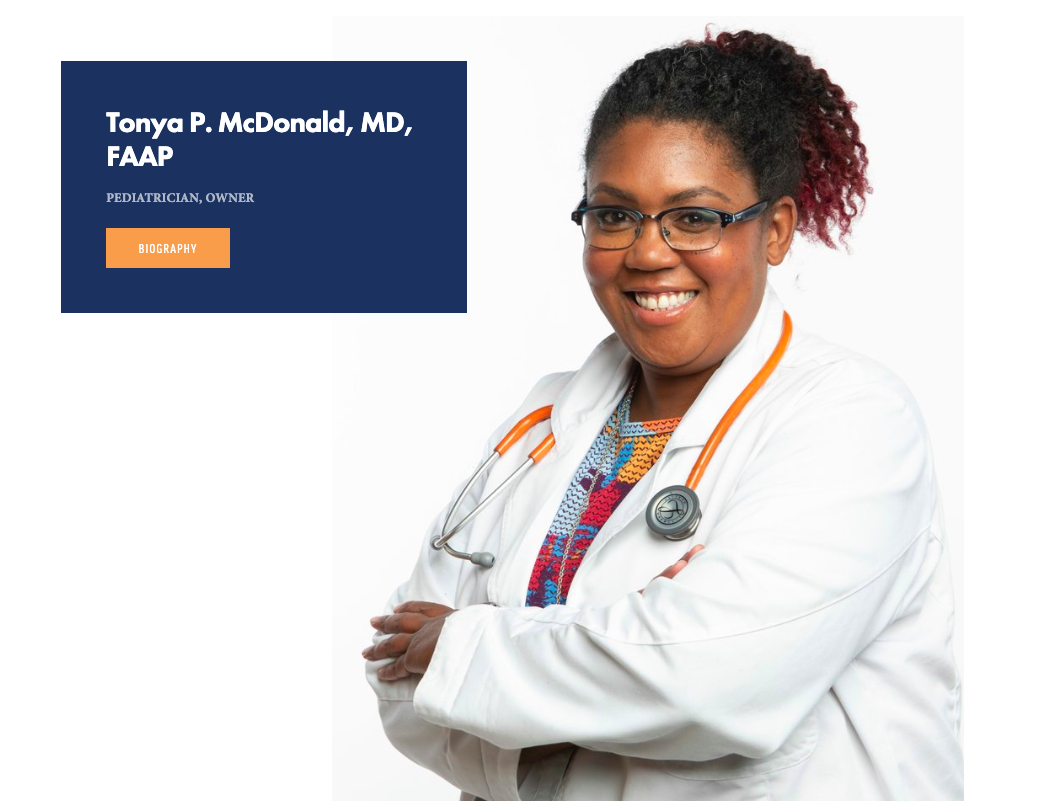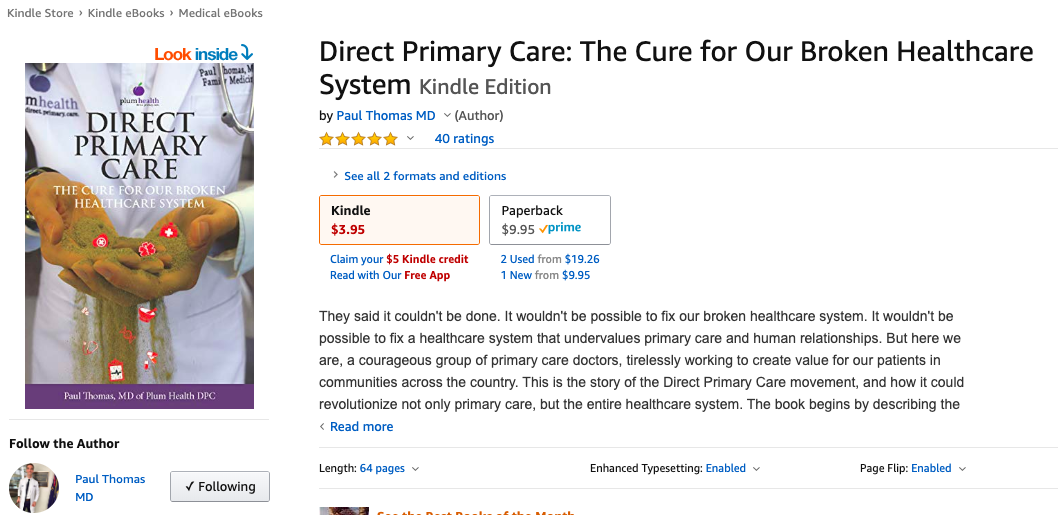Without further ado, here are the questions:
First of all, thank you for writing this book. I absolutely love the fundamental principles of family medicine but was discouraged when I saw very busy doctors during my rotation getting burned out. All of the reasons to go into primary care (or medicine in general) that you had mentioned in your book very much resonated with me. I want to be the change and provide the care that my future patients deserve.
Like I mentioned to you before, I did have some followup questions:
What is your patient population like in your Direct Primary Care practice?
Regarding patient population, what type of patients do you mostly see? If patients have to pay a monthly fee, I would think that you mostly see people who need frequent care i.e. kids with recurrent infections/asthma attacks/allergies and elderly with many chronic diseases. What proportion of your patients is in their 20-40s? And I wouldn’t think Medicaid patients who join the membership since they can see doctors for free (or ~$5). Trying to get a sense of what type of patients I’ll see if I go into this.
First, our patient population is broad and diverse. Our youngest patient is 6 months old and our oldest patient is now 102 years old. However, the majority of our patients are in the 30 to 65 years of age range. They typically have some sort of health insurance, but they choose to use our service because we offer a wow experience and deliver excellent care and service with each visit.
Our patients have very diverse financial situations as well. We take care of many people who fall through the cracks of the traditional system. For instance, we take care of many people who are bartenders, hairdressers, and truck drivers. These folks earn too much to qualify for Medicaid, but don’t earn enough to afford private health insurance coverage. The cutoff for Medicaid in Michigan is roughly $17,000 for an individual.
But some of our patients are independently wealthy, the business elite in our community. They use our services because we offer excellent service, on-time appointments, and no-wait appointments.
We also work with businesses to take care of their employees. Many business have fewer than 50 full-time equivalent employees. When this is the case, the business is not mandated to offer private health insurance. But, many of these businesses want to offer some sort of health care benefit to their employees, so they choose our service.
How can you help patients who can’t afford your Direct Primary Care membership fees?
And about the patient with herpes outbreak you mentioned, was she financially capable of paying the monthly fee to get the care from you? Did she have to agree on the membership fee before she could get the medications she needed? Do you have different payment plans for those who can’t afford the regular prices? How do you go about doing that to offer care to the financially unstable individuals, while not making it seem unfair to those paying the regular prices?
For that particular patient, she is still a member of our service. She comes in quarterly to have her chronic medical conditions managed, including her herpes simplex virus. She is financially capable of paying our monthly fee - she drives a bus for a local school district and cannot afford private insurance, but she can afford our primary care service.
As for folks who can’t pay for our service, we offer a number of ways to help people in our community and to do no financial harm. First, if someone cannot afford our services, we can send them resources to help them enroll in Medicaid or a discounted Affordable Care Act plan. There are also free clinics in our community and FQHCs that we recommend. For our patients who can no longer afford our membership fees, we help them to find a doctor who they can afford through the above resources, and then we close out their account. We don’t send people who can’t pay to collections.
Are patients joining your Direct Primary Care practice because of high costs?
Regarding finances, what are the common complaints that your patients have? Do they have trouble paying for expensive imaging tests (and in that case, do you refer people to specialists that are covered by their insurance)? Do they have problems meeting their deductible since membership fees don’t count towards their deductible? And do you foresee a policy change in the near future that will allow patients to have their membership fee count towards their deductible?
Our patients are concerned about the high cost of care across the board. Every week we help someone find a lower price on labs, medications, and imaging services. We leverage local resources, like independent or free-standing imaging centers, to get cash prices on imaging studies that are often 50 to 90% lower than what these same imaging services companies charge insurance carriers.
I have not heard any concerns from my patients about our membership fees not being categorized as a qualifying expense for their health insurance deductibles. I’ve never had a patient leave my service for the above reason. I don’t really see public policy changing in this regard.
That being said, most people don’t sign up for our service to save money. They sign up for our service because they have access to a trusted physician.
The Growing Direct Primary Care movement and System Changes
Regarding the future of DPC, as DPC gets more ubiquitous (which I am hoping it will), what potential problems do you see arising? Is there effort being made to change the healthcare system in a way that separates primary care from insurance? And how do you see DPC surviving in a society where big hospitals are dominating over healthcare?
You’re right - DPC is growing! When I first started my practice in November 2016, there were roughly 400 Direct Primary Care practices across the country. Now, there’s roughly 1,200 DPC practices across the country! This is exciting because it’s starting to become normal for people to have a Direct Primary Care doctor - it’s no longer a fringe thing to have a DPC doc.
Ideally, DPC would grow to have every primary care physician and every person in the United States using the DPC model of care. Pragmatically, there’s probably an 80/20 rule at play, where 80 percent of people are comfortable with their health insurance and 20 percent of people are willing to make a change to DPC.
I think the overall healthcare system has started to change. People have started to see their insurance as a tool to protect them from bankruptcy and our services in the Direct Primary Care model as a way to get excellent primary care service.
I see Direct Primary Care surviving and thriving in any environment. We’ve already seen DPC docs create successful practices in urban, rural, suburban, wealthy, middle class, and economically disadvantaged neighborhoods. Hospitals already dominate our healthcare ecosystem here in Detroit, and we’ve been very successful in growing our DPC practice because we give patients what those juggernauts can’t - a reliable, personable, supportive, caring, empathetic physician that is available when our patients need us.
Weaknesses in the Direct Primary Care Model
And lastly, what are some of the weaknesses of DPC that you see? Where do you see a need for improvement? Are there any limitations as a DPC doctor as opposed to a normal family medicine doctor (visiting patients in the hospital, delivering babies, etc.)?
The biggest weakness in Direct Primary Care is probably vaccine costs for children. Vaccines are free for most kids and families because of insurance coverage and Medicaid coverage. However, because we don’t bill or use insurance, we cannot get vaccines for the children in our practice for free. How we solve this in our clinic is to send children and families to local health departments or the hospital’s no-questions-asked vaccine clinic. In the future, there would be a great opportunity for a company to bill insurance on behalf of DPC doctors for vaccines only.
Can Direct Primary Care alleviate physician burnout?
You mentioned that DPC reduced your burnout but when you do feel burned out, what usually causes it?
As for burnout, I was feeling burned out for a number of reasons. I felt like I was spending far too much time on mandated data entry tasks, and ultimately that data was not useful for the individual health of my patients. I felt like I couldn’t get the care that I needed for my patients due to restrictive care networks and prior authorizations. I was feeling burned out because I was experiencing a loss of autonomy over my work.
I usually feel burnout when I’m overwhelmed with trivial tasks that don’t help my patients live healthier lives. I want to maximize the time I spend counseling and caring for my patients and minimize the time I spend typing into my computer or checking boxes. Practicing in the Direct Primary Care has allowed me to accomplish both of those goals.
Thank you for writing this book. I’m sure you’re inspiring not only your patients, but also future doctors, policymakers, and other healthcare workers. I hope this is the stepping stone towards transforming the broken healthcare system.
Looking forward your response, Xxxx Xxxxxxxx
Thank you for your questions, I’m sincerely happy to help. - Dr. Paul Thomas with Startup DPC












